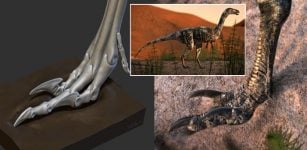Great Mystery Of Flying Reptiles (Pterosaurs) – Finally Solved
Eddie Gonzales Jr. – MessageToEagle.com – Researchers have solved one of the biggest mysteries regarding flying reptiles (pterosaurs) that dominated the skies during the Age of the Dinosaurs and included the largest flying animals ever.
Pterosaurs spread around the world during the time of the dinosaurs.
 Lagerpetid from Brazil -Ixalerpeton, 233 MA- illustrated by Rodolfo Nogueira and the pterosaur Aerotitan sudamericanus studied in 2012 and illustrated by Gabriel Lio.
Lagerpetid from Brazil -Ixalerpeton, 233 MA- illustrated by Rodolfo Nogueira and the pterosaur Aerotitan sudamericanus studied in 2012 and illustrated by Gabriel Lio.
They usually appear in books and movies, but, for more than 200 years, until today, their origin was unknown.
In the fossil record, no closely related species or group of reptiles has ever been found to show how these reptiles evolved to conquer the sky. This great gap in the fossil record was completed from a study carried out by a large international team of Argentine, American, Brazilian and European paleontologists.
“The first pterosaurs were found during the late eighteenth century and, from that time, it was observed that they had an anatomy, a body plan that was very different from that of other known reptiles, having wings formed by membranes, supported by an hyper developed fourth finger of the hand (the ring finger in humans), which is a unique feature of pterosaurs,” author of the study Dr. Martín Ezcurra, of the Argentine Museum of Natural Sciences in Buenos Aires, sdaid in a press release.
The new study published in the journal Nature, fills a large gap, by revealing which were the terrestrial relatives of pterosaurs, these flying animals that arose about 220 million years ago and that coexisted with dinosaurs during almost the entire Mesozoic Era, until they shared their extinction 66 million years ago.
“This discovery was produced from a combination of different findings that we had been making in search to better understand the origin of dinosaurs”, Ezcurra said, adding that one of the groups that were considered as dinosaur precursors are the enigmatic lagerpetid reptiles, of which very few parts of their body were known.
 Reconstruction of the head and neck of the Ixalerpeton lagerpetid from the Triassic period from southern Brazil. Illustration: Rodolfo Nogueira.
Reconstruction of the head and neck of the Ixalerpeton lagerpetid from the Triassic period from southern Brazil. Illustration: Rodolfo Nogueira.
“But, based on new findings of the jaw and skull of lagerpetid species in Brazil, Argentina and the United States, we were able to detect that these terrestrial reptiles were closely related to the famous pterosaurs”.
In this study, pterosaurs were compared with different lagerpetid species, whose oldest specimens – more than 230 million years old – measured between one meter and one and a half meters, while the most recent – about 210 million years old – reached three meters in length.
“When we analyzed the lagerpetid from La Rioja, we saw these very rare characteristics in the dentition and we considered the possibility that it was part of this species called Lagerpeton chanarensis or that it wasn’t a lagerpetid.
“We were not certain, but when we later saw the lagerpetid from Brazil accompanied by a jaw with similar characteristics, we were able to confirm that these pterosaur-like teeth belonged to these lagerpetids”.
Now, the team compared the pterosaurs not only with the lagerpetid from Argentina (Lagerpeton, 236 million years old), but also with the lagerpetid found in southern Brazil in 2016 (Ixalerpeton, 233 million years old antiquity).
This whole study contains more than 820 skeletal brain characteristics, as well as features of the inner ear, using 158 species of fossil reptiles from different parts of the world.
Based on this material, the researchers could reveal the new relationship between lagerpetids and pterosaurs.
Read more in the original story – here
Written by Eddie Gonzales Jr. – MessageToEagle.com Staff
Related Posts
-
 ‘Colobops’ Small Reptile With Little But Massive Jaws Lived In Connecticut 200 Million Years Ago
No Comments | Mar 27, 2018
‘Colobops’ Small Reptile With Little But Massive Jaws Lived In Connecticut 200 Million Years Ago
No Comments | Mar 27, 2018 -
 Mystery Of Color Patterns Of Reef Fish – Solved
No Comments | Dec 5, 2018
Mystery Of Color Patterns Of Reef Fish – Solved
No Comments | Dec 5, 2018 -
 ‘Cthulhu’ Fossil: Extinct 430-Million-Year-Old Sea Cucumber In 3D Reconstruction
No Comments | Apr 11, 2019
‘Cthulhu’ Fossil: Extinct 430-Million-Year-Old Sea Cucumber In 3D Reconstruction
No Comments | Apr 11, 2019 -
 Plant Whose Sex Life Fascinated Charles Darwin
No Comments | Dec 12, 2018
Plant Whose Sex Life Fascinated Charles Darwin
No Comments | Dec 12, 2018 -
 Ants Have Their Own Internet – The ‘Anternet’
No Comments | Aug 29, 2012
Ants Have Their Own Internet – The ‘Anternet’
No Comments | Aug 29, 2012 -
 ‘Vespersaurus paranaensis’: Small Predator That Lived 85 Million Years Ago Discovered In Brazil
No Comments | Jun 28, 2019
‘Vespersaurus paranaensis’: Small Predator That Lived 85 Million Years Ago Discovered In Brazil
No Comments | Jun 28, 2019 -
 Electricity-Eating Bacteria Can Help Fight Environmental Pollution
No Comments | Mar 12, 2019
Electricity-Eating Bacteria Can Help Fight Environmental Pollution
No Comments | Mar 12, 2019 -
 Fossils Of Flying Reptiles In The Sahara 100 Million Years Ago – Investigated
No Comments | Mar 26, 2020
Fossils Of Flying Reptiles In The Sahara 100 Million Years Ago – Investigated
No Comments | Mar 26, 2020 -
 400-Million-Year- Old Fossilized Armored Worms Brought To ‘Virtual’ Life
No Comments | Dec 9, 2021
400-Million-Year- Old Fossilized Armored Worms Brought To ‘Virtual’ Life
No Comments | Dec 9, 2021 -
 Surprising Discovery Reveals Plants Are Capable Of Making Complex Decisions
No Comments | Jul 30, 2014
Surprising Discovery Reveals Plants Are Capable Of Making Complex Decisions
No Comments | Jul 30, 2014
